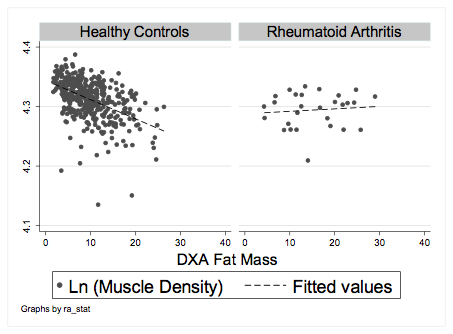Session Information
Title: Rheumatoid Arthritis - Clinical Aspects II: Clinical Features & Comorbidity/Cardiovascular Disease
Session Type: Abstract Submissions (ACR)
Background/Purpose: Fatty infiltration of muscle (myosteatosis) results in a decrease in muscle density. Prior studies documented that skeletal muscle attenuation determined by CT was associated with skeletal muscle lipid content on tissue biopsy. Low muscle density is associated with insulin resistance and is independently associated with an increased fracture risk. We evaluated muscle density as measured by peripheral quantitative CT (pQCT) in 28 subjects with rheumatoid arthritis (RA) compared to 464 well-characterized controls.
Methods: RA subjects and healthy controls from the Philadelphia area underwent whole-body Dual X-ray Absorptiometry (DXA) and pQCT of the tibia. The pQCT measure of muscle density (mg/cm3) was used as a composite index of intra and extra-myocellular fat content as previously described. Edge-detection and threshold techniques were used to separate tissues (fat, muscle, and bone) based on attenuation characteristics. Images were filtered prior to being analyzed using contour mode 3 (-101 mg/cm3) to find skin, and peel mode 2 (40 mg/cm3) to separate adipose and muscle/bone, respectively. Whole body DXA measures of total fat mass were converted to an index to adjust for height (kg/m2). Muscle density was compared between RA and controls after adjusting for age, sex, and race using multivariable linear regression analysis. Linear regression was further utilized to assess for differences in RA and controls after adjustment for differences in total fat mass and to evaluate for modification of the association between fat and muscle density among RA subjects.
Results: Adjusted mean muscle density in RA and controls was 73.3 (2.08) and 74.5 (2.01), respectively (p=0.003). There was significant modification of the effect of fat mass on muscle density in RA [Interaction β: 0.0038 (0.0018-0.0057) p<0.001]. In healthy controls, muscle density was negatively associated with total fat mass index (FMI), while among RA, there was no such association (Figure 2). This interaction suggested that differences in muscle density between RA and controls were most pronounced among subjects with lower fat mass. Use of steroids, use of biologics, disability scores, C-Reactive Protein (CRP) and disease activity (DAS28) were not significantly associated with muscle density in this small sample of RA.
Conclusion: Muscle density is lower in RA subjects compared to healthy controls of similar age, sex, and race. Differences in muscle density are not dependent on the greater fat mass observed among RA subjects. The interaction observed between RA status and FMI suggests that the mechanism of myosteatosis in RA may be distinct from that of healthy controls.
Figure 1: Association between DXA fat mass index (FMI) and muscle density among Healthy Controls and Rheumatoid Arthritis after adjustment for age, sex, and race.
Disclosure:
J. Baker,
None;
J. M. Von Feldt,
American Board of Internal Medicine,
6;
M. B. Leonard,
None.
« Back to 2012 ACR/ARHP Annual Meeting
ACR Meeting Abstracts - https://acrabstracts.org/abstract/low-muscle-density-in-rheumatoid-arthritis-and-modified-association-with-total-fat-mass-results-of-a-pilot-study/

